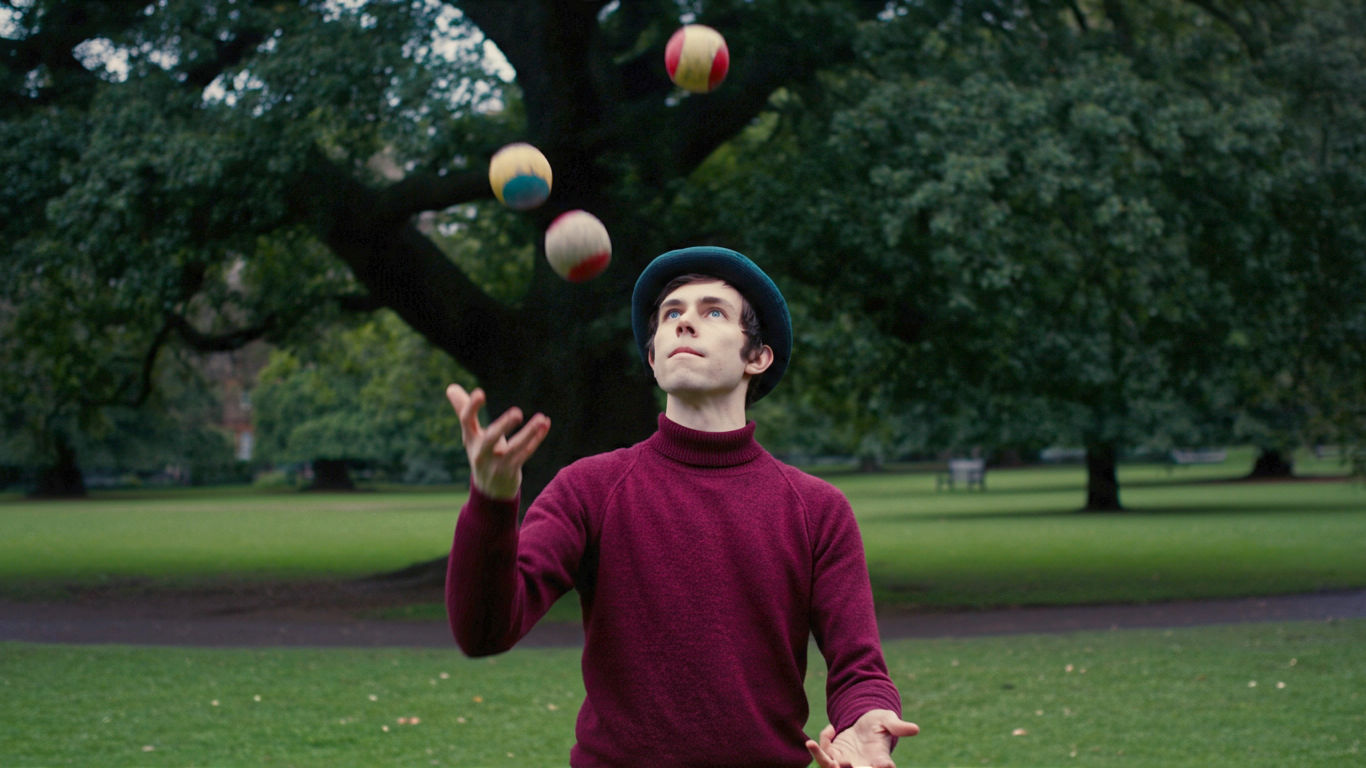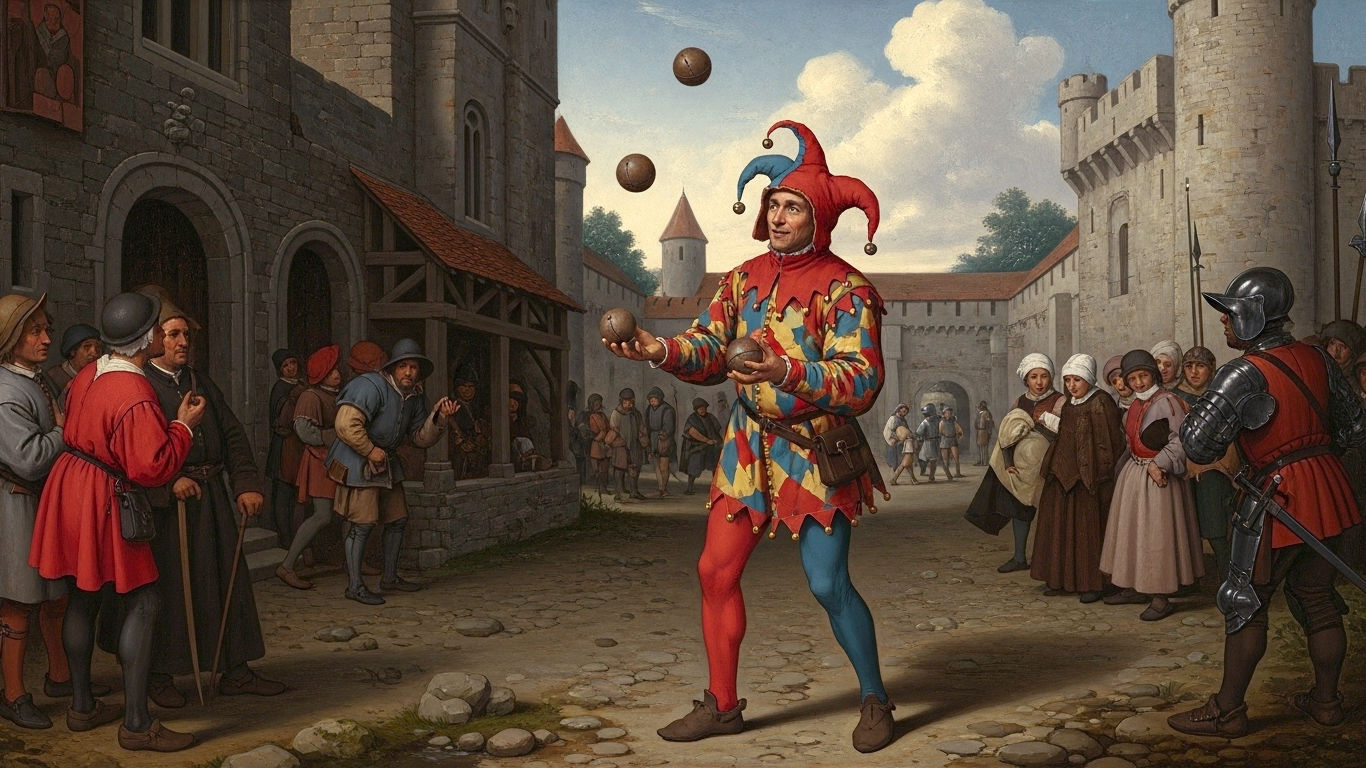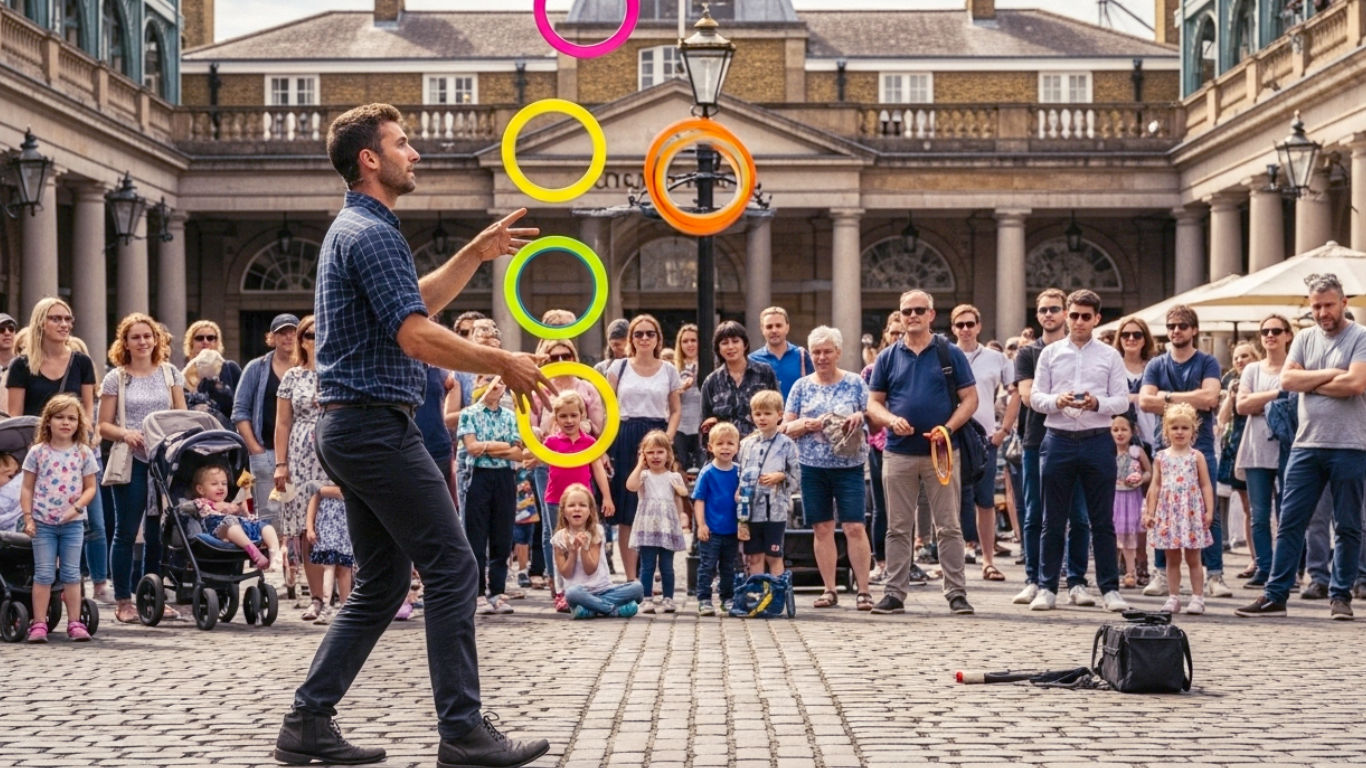The Art of Keeping Objects in the Air: A Complete Guide to Juggling
Discover the art of juggling. Our guide explores its ancient history, the brain-boosting science, and a simple, step-by-step tutorial for beginners.

This post may contain affiliate links. If you make a purchase through these links, we may earn a commission at no additional cost to you.
Let’s be honest, we’ve all seen it. A street performer in Covent Garden, surrounded by a captivated crowd, effortlessly keeping three, four, or even five objects dancing in the air. Or perhaps a friend at a festival, lost in concentration, looping a set of colourful balls in a hypnotic rhythm. It’s a sight that feels like a little bit of everyday magic. It’s called juggling, and while it might look like a superhuman feat, it’s a skill built on a simple foundation of physics, focus, and a fair bit of practise.
Juggling is so much more than just throwing and catching. It’s an ancient art form, a challenging sport, a powerful tool for brain development, and a deeply satisfying hobby. It’s a conversation between your hands, your eyes, and the unwavering force of gravity. It’s about finding order in chaos and creating a moment of suspended wonder.
This guide is your complete exploration of that world. We’ll journey from the tombs of ancient Egypt to the modern circus stage. We’ll break down the science of how it works and give you a step-by-step plan to throw your first proper pattern. We’ll even look at how this simple act can literally grow your brain. Whether you’re a complete beginner who’s never even held a juggling ball or just curious about this fascinating skill, you’re in the right place. So, grab a brew, get comfortable, and let’s dive into the art of keeping things in the air.
What Exactly Is Juggling? The Core Concepts
At its heart, juggling is the art of manipulating objects to keep more of them in the air than you have hands to hold them. For most people, this means starting with three objects and two hands. It’s not about having lightning-fast reflexes, but about creating a precise and consistent pattern of throws.
Think of it like this: your right hand doesn’t just throw to your right hand. It throws in a gentle arc to where your left hand will be. And your left hand does the same in return. The objects follow a predictable path—often a figure-of-eight on its side—and your hands simply move to the right place at the right time to catch and throw again. It’s a rhythmic exchange, a continuous loop where each object gets its moment to fly. The key isn’t speed; the key is the accuracy and consistency of your throws. A good throw lands exactly where it should, making the catch feel easy. A bad throw is what causes all the trouble.
The Juggler’s Tools: More Than Just Balls
While brightly coloured balls are what most people picture, jugglers use a variety of props, each with its own unique challenge and character.
Balls: The Classic Starting Point
Juggling balls are the bread and butter of the juggling world. They’re the best place for any beginner to start because their flight path is simple and predictable. They don’t have to be anything fancy; in the beginning, even a few sturdy oranges or rolled-up socks will do the trick.
Proper juggling balls are usually called ‘thuds’ or beanbags. They are soft, slightly squishy, and filled with seed (like millet) or plastic pellets. This gives them a nice weight in the hand and, crucially, means they don’t bounce or roll away when you drop them—and you will drop them. A lot.
Clubs: The Spinning Challenge
Juggling clubs look a bit like bowling pins or skittles. They add a whole new layer of complexity: spin. When you throw a club, you have to give it the right amount of rotation so you can catch it cleanly by the handle. A single spin is standard for a normal throw, but performers can throw double, triple, or even quadruple spins for a flashier effect.
They are much harder to learn than balls. The spin makes timing critical, and getting hit by the wrong end of a hard plastic club can smart a bit. But their spinning, twirling motion is visually stunning, making them a favourite for stage performers.
Rings: The Flashy Performer’s Choice
Rings are thin, solid hoops. They are light, fast, and unforgiving. Because they are so thin, you have to be incredibly precise with your catches. There’s very little room for error.
So why use them? They look incredible. When spun, they create a mesmerising optical illusion. And because they are flat, a juggler can hold many of them in one hand, allowing for impressive tricks where they launch a whole volley of rings into the air at once. They are strictly for performers who want to create a big, visual spectacle.
Beyond the Usual Suspects
The world of juggling extends far beyond these three main props. You’ll see performers using everything from cigar boxes and devil sticks to the hypnotic, rolling motion of contact juggling (where the ball never leaves the body) and the spinning, soaring diabolo, a favourite in school playgrounds across Britain.
A Spin Through Time: The Surprising History of Juggling
Juggling isn’t a modern invention. It’s an ancient art that has been captivating audiences for thousands of years, weaving its way through history from royal courts to muddy village greens.
Ancient Roots
The oldest known depiction of juggling comes from ancient Egypt. A painting in the Beni Hasan tomb complex, dating back almost 4,000 years, clearly shows figures tossing balls in the air. It seems our desire to defy gravity is nothing new. The art form popped up across the ancient world, with mentions in Greek and Roman texts. There are even records of female gladiators who were famed for their ball-handling skills. In ancient China, warriors would reportedly show off by juggling swords before battle—a surefire way to intimidate the opposition.
The Jester and the Dark Ages

During the Middle Ages in Europe, juggling went underground. It became the trade of travelling entertainers, jesters, and mountebanks who moved from town to town. They were often seen as vagrants or tricksters, but they kept the skills alive. The classic image of the court jester in his floppy, bell-covered hat almost always includes a set of juggling balls. They were the keepers of the craft through a time when public performance was often frowned upon.
The Birth of Modern Juggling
Everything changed in the 19th century with the rise of vaudeville in America and music hall in Britain. For the first time, performers could make a respectable living on stage, and juggling became a headline act. This was the era of the “gentleman juggler.”
One of the first global superstars was Paul Cinquevalli. Though German-born, he made his name in Britain and was a true showman. He juggled cannonballs, plates, and bottles, often while balancing on a trapeze or a high-wire, all dressed in a leopard-skin leotard. He set the template for the performer who combined incredible skill with dazzling stage presence.
But the man many still consider the greatest juggler of all time was Enrico Rastelli. An Italian performer from the early 20th century, Rastelli took juggling to a whole new level of technical brilliance. He could juggle ten balls at once, a feat that is still world-class today. He wasn’t just a trickster; he was an artist who could also balance and kick objects with unbelievable precision. He became a household name and earned a fortune, proving that juggling could be a true art form.
The Juggling Renaissance
After the decline of vaudeville, juggling became less of a public spectacle and more of a niche hobby. But in the latter half of the 20th century, something wonderful happened. The founding of the International Jugglers’ Association (IJA) in 1947 gave hobbyists a way to connect and share ideas. New materials, like plastic and silicone, made high-quality props available to everyone.
A new generation discovered that juggling wasn’t just for circus performers; it was a fun, challenging, and accessible activity for anyone. This renaissance is what led to the vibrant communities, university clubs, and juggling conventions we see today.
Your First Steps: How to Juggle Three Balls
Right, enough theory. It’s time to have a go. This is the part that looks impossible but is actually a simple process of building one small step on top of another. Forget everything you think you know about juggling. We’re going to start from scratch.
Step 0: Get the Right Gear (and Mindset)
First, find three objects of a similar size and weight. As we mentioned, thud-style juggling balls are best, but you can start with small fruit (like satsumas or clementines) or even tightly rolled-up socks. Avoid anything that bounces, like tennis balls—you’ll spend more time chasing them than juggling!
Find a clear space away from breakable things like lamps and tellys. Stand relaxed, with your feet shoulder-width apart and your elbows bent at a 90-degree angle, tucked loosely into your sides. You should look like you’re about to carry a tray.
Most importantly, be patient. You will drop things. Dropping isn’t failing; it’s part of the process. Every drop is a clue telling you what went wrong with your throw.
Step 1: The One-Ball Throw
This sounds ridiculously simple, but it’s the most important step. The quality of your throw determines everything.
- Hold one ball in your dominant hand (we’ll assume you’re right-handed for this guide).
- Throw the ball in a gentle arc towards your other hand. It should peak at about eye level.
- The path is crucial. It shouldn’t go straight up, and it shouldn’t go forward. It should travel from one hand to the other in a graceful curve.
- Catch it with your left hand, letting your hand dip slightly to absorb the impact.
- Now, do the same thing back from your left hand to your right.
Practise this for a good five to ten minutes. The goal is a perfect, consistent, and relaxed throw that lands comfortably in your other hand every single time. This is the foundation of your entire juggling career!
Step 2: The Two-Ball Exchange (The “Flash”)

Now we introduce a second ball. This is where the juggling rhythm begins.
- Hold one ball in each hand. We’ll call them Ball 1 (right hand) and Ball 2 (left hand).
- Throw Ball 1 from your right hand, using that same perfect arc you just practised.
- When Ball 1 reaches its peak (at eye level), throw Ball 2 from your left hand.
- Ball 2 should travel underneath the path of Ball 1.
- Catch Ball 1 with your now-empty left hand.
- Catch Ball 2 with your now-empty right hand.
The timing is everything. It’s a quick throw-throw-catch-catch. The first throw triggers the second. Don’t rush it. The rhythm is steady: “Throw… throw… catch… catch.”
Practise this until it feels smooth and controlled. Start with your dominant hand, then switch and lead with your non-dominant hand. You should be able to do this comfortably from both sides before moving on. This two-ball exchange is the heart of the three-ball pattern.
Step 3: Putting It All Together: The Three-Ball Cascade
This is the moment. It probably feels like a huge leap, but it’s just one more throw added to the pattern you’ve already learned.
- Hold two balls in your right hand (Ball 1 and Ball 3) and one in your left (Ball 2). Don’t grip them tightly; just cup them gently.
- Start by throwing Ball 1 from your right hand, just like in the two-ball exchange.
- As Ball 1 peaks, throw Ball 2 from your left hand, underneath it.
- Here’s the new bit: As Ball 2 peaks, your right hand will now be free (because you just threw Ball 1). Throw Ball 3 from your right hand, underneath Ball 2.
- Your immediate goal is just to make that third throw and then catch the balls. Even just catching one or two is a huge success at first.
The full pattern, the Three-Ball Cascade, is just a continuation of this. Each time a ball reaches its peak, you throw the next ball from the hand that’s about to receive it. It’s a continuous loop: right-hand throw, left-hand throw, right-hand throw, left-hand throw…
Your first attempts might be a complete muddle. That’s normal! Focus on the throws, not the catches. Aim for those nice, consistent eye-level arcs. If you can make three good throws, the catches will eventually take care of themselves.
Common Problems and How to Fix Them (“Troubleshooting Your Throws”)
- Problem: The balls are flying forward, and I have to walk to catch them.
- Solution: You’re probably throwing the balls away from you instead of across your body. Try practising in front of a wall. This will force you to keep your throws in a flat plane.
- Problem: The balls are crashing into each other in the middle.
- Solution: Your timing is off. You’re likely throwing the second ball too early. Wait until the first ball reaches the very top of its arc before you make the next throw.
- Problem: I’m panicking and throwing the balls too high.
- Solution: Relax! Take a deep breath. Go back to the one-ball throw and rediscover that calm, gentle arc to eye level. Speed and height are not your friends right now. Consistency is.
Learning to juggle takes time. Some people get it in an afternoon; for others, it might take a few weeks of practise. Stick with it. The moment you achieve your first clean run of six or seven catches is a truly magical feeling of accomplishment.
The Juggler’s Brain: What Science Says About Juggling
For a long time, scientists believed that the structure of the adult brain was fixed. But a groundbreaking study in 2004, published in the journal Nature, used juggling to prove that’s not the case. The brain can change, adapt, and grow—a concept called neuroplasticity.
Researchers at the University of Regensburg in Germany took a group of people who had never juggled before and scanned their brains. They then taught them to juggle three balls and asked them to practise every day. After three months, they scanned their brains again. The results were astonishing.
The jugglers showed a measurable increase in grey matter in two areas of the brain: the mid-temporal area (involved in visual motion tracking) and the left posterior intraparietal sulcus (linked to reaching and grasping for objects). In simple terms, the parts of the brain responsible for tracking and catching the balls had physically grown bigger and denser. It’s like a workout for your brain tissue.
Even more interesting, when the participants stopped juggling, the new grey matter began to shrink back. This showed that the brain is a “use it or lose it” organ. The act of learning and practising a new, complex physical skill forces the brain to build new connections and strengthen existing ones.
Juggling is a full-body, full-brain activity. It improves:
- Hand-eye coordination: This is the most obvious benefit.
- Focus and concentration: You can’t think about your shopping list while you’re juggling. It demands complete presence.
- Peripheral vision: You learn to see the whole pattern, not just one ball.
- Rhythm and timing: It’s a deeply rhythmic activity.
- Problem-solving: Figuring out a new trick is a physical puzzle.
So, the next time you see someone juggling, know that you’re not just watching a neat trick. You’re watching a brain being rewired and strengthened in real time.
Beyond the Cascade: A World of Patterns and Props
Once you’ve mastered the basic three-ball cascade, a whole new universe of possibilities opens up. The cascade is just the “hello world” of juggling. There are hundreds of other patterns to learn, each with its own rhythm and feel.
Some popular next steps include:
- Columns: Where the balls are thrown straight up and down in their own vertical lanes.
- The Shower: A more challenging pattern where two balls are quickly passed from one hand to the other in a low arc, while the third ball is thrown in a high arc over the top. It’s what you often see in cartoons.
- Juggling with more objects: The leap from three balls to four is a big one. With an even number of objects, the patterns change. Instead of crossing over, each hand juggles its own objects independently (this is called a Fountain). Five balls is another huge challenge, returning to the crossing cascade pattern but much faster and higher.
Cracking the Code: A Gentle Introduction to Siteswap
As jugglers started inventing more and more complex patterns, they needed a way to write them down and share them. The solution was a wonderfully clever system called Siteswap.
At first glance, it looks like a line of computer code gone wrong—a string of numbers like ‘441’ or ‘531’. But the idea is simple. Each number represents a throw. The number tells you how many “beats” later that same object will be thrown again.
- A ‘3’ is the standard throw in a three-ball cascade. It crosses from one hand to the other and lands three beats later. The pattern for a cascade is just ‘3’.
- A ‘4’ is a throw from one hand back to the same hand (like in the four-ball fountain). It lands four beats later.
- A ‘1’ is a quick, low pass straight from one hand to the other.
- A ‘0’ is an empty hand for one beat.
By combining these numbers, jugglers can describe almost any pattern imaginable. The sequence ‘531’, for example, describes a famous trick with one high throw (the ‘5’), one normal crossing throw (the ‘3’), and one quick zip across (the ‘1’). It’s the language of juggling, and it allows performers to invent and share incredibly complex sequences. You don’t need to understand it to be a good juggler, but it shows the hidden mathematical beauty behind the art.
Juggling in British Culture: From Street Corners to the Big Top

In Britain, juggling has a vibrant and visible presence. It’s woven into the fabric of our summer festivals, our city centres, and our thriving circus scene.
The Street and the Festival
You can’t walk through a major city centre on a sunny weekend without stumbling upon a street performer, or “busker.” Covent Garden in London is the most famous hub, a sort of unofficial pilgrimage site for street entertainers from around the world. Here, juggling is combined with comedy, acrobatics, and a whole lot of audience interaction to create shows that are a quintessential part of the London experience.
Beyond the cities, juggling is a core part of the festival scene. From Glastonbury to the Edinburgh Fringe, you’ll find dedicated circus and performance areas where jugglers and flow artists gather to practise, perform, and share their skills in a relaxed, communal atmosphere.
The UK’s Thriving Circus Scene
Britain is home to a fantastic contemporary circus movement. Companies like NoFit State Circus and Giffords Circus blend traditional skills like juggling with theatre, dance, and live music to create breathtaking narrative shows. This has helped to elevate juggling from a simple variety act to a respected form of physical theatre.
The Community and the Convention
For the hobbyist, there is a warm and welcoming community across the country. Most universities have a “Juggling and Circus Skills” society, which are often the best places for beginners to get free lessons and meet fellow enthusiasts.
The highlight of the year is the British Juggling Convention (BJC). It’s the longest-running national juggling convention in the world, a four-day festival that moves to a different city each year. Hundreds of jugglers of all skill levels gather to attend workshops, watch world-class shows, and spend hours just jamming and sharing tricks in a giant sports hall. It’s a testament to the friendly, open, and slightly eccentric spirit of the juggling community.
The Future of Juggling: Where Does It Go From Here?
Juggling is constantly evolving. The technical level today is higher than it has ever been. Jugglers are not just adding more objects—the world record is currently 14 rings, 13 balls, and 9 clubs—but are also blending the art with dance, acrobatics, and digital technology.
LED and programmable props have opened up a whole new world of visual performance. Jugglers can now create stunning light shows in the dark, with clubs and balls that change colour and display images as they spin through the air.
At its core, however, the appeal of juggling remains timeless. It’s the simple, honest challenge of man versus gravity. It’s the satisfaction of taking a chaotic system and imposing a beautiful, rhythmic order upon it. It’s the quiet joy of getting lost in the flow, where the rest of the world melts away and there is only the gentle loop of throwing and catching.
Conclusion: Ready to Pick Up the Balls?
We’ve travelled from ancient history to modern neuroscience, from the simple one-ball throw to the complexities of siteswap. We’ve seen that juggling is far more than a circus trick; it’s a discipline that builds focus, enhances creativity, and physically reshapes the brain.
It’s an art form open to everyone, regardless of age or athletic ability. All it requires is a little patience and the willingness to pick things up when you drop them—a good lesson for life, not just for juggling.
So why not give it a try? Find three objects. Find a bit of space. Start with that simple, single throw. You might just surprise yourself. You might discover a new passion, a new community, and a new way of looking at the world. After all, you’re not just learning to keep objects in the air; you’re learning the art of focus, perseverance, and creating your own little moment of magic.
Further Reading
For those wishing to delve deeper into the world of juggling, these resources are highly respected within the community:
- The International Jugglers’ Association (IJA): The global organisation for jugglers, featuring articles, tutorials, and competition videos. https://www.juggle.org
- The Juggling Edge: A massive community forum and resource database for jugglers of all levels. https://www.jugglingedge.com/
- Oddballs Juggling: A well-known UK-based shop for all juggling and circus equipment, with helpful guides and product information. https://www.oddballs.co.uk
- Luke Burrage’s Juggling Tutorials: A fantastic collection of in-depth video tutorials on YouTube, especially for learning Siteswap and advanced tricks. https://www.youtube.com/@lukeburrage






